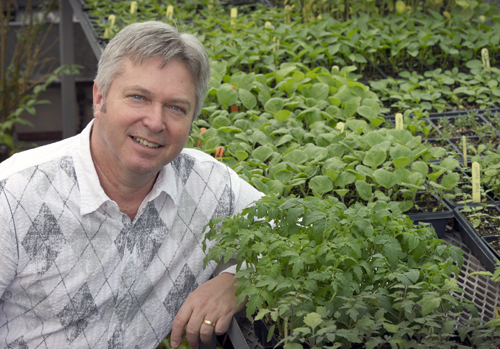By Megan Cowie, Students Promoting Awareness of Research Knowledge (SPARK)

Life on Mars is possible, researchers say, and they’re not talking about “little green men.” Thanks to recent advancements in light-emitting diode (LED) technology, it may be possible to grow plants anywhere – even on the Red Planet, where sunlight is weak.
A team of University of Guelph researchers is looking for ways to use LEDs to reduce the costs of growing food on other planets, notably Mars and the moon. Canada currently leads the world in this niche of space exploration, which will ultimately make space travel more feasible.
The technology they’re developing will also enable plant growth in extreme environments here on Earth, from Northern Canada, where the temperature can drop to -50 C, to deserts in the Middle East, where the heat can reach 50 C. Growing food in these areas would reduce the costs of transporting it there.
The project, called InTICE (Innovative Technologies in Challenging Environments), is led by Profs. Mike Dixon, Department of Environmental Biology, and Bernard Grodzinski, Department of Plant Agriculture.
“The challenges with food production in space are the same as those you’ll face in a snowbank in Yellowknife or a desert in Kuwait,” says Dixon. “Ultimately, we’ll be able to grow our own strawberries in Northern Canada, instead of paying $24 per kilo in some of the more remote communities for strawberries imported from Mexico or California.”
One of the team’s goals is to grow plants using LED lights without relying on energy from the sun. LEDs have recently been used in greenhouses to supplement the sun’s rays and to maximize plant growth, but efforts to use LEDs to replace solar energy altogether are in the early stages.
Still, LEDs may be used to grow plants because it’s easy to control which wavelengths – or how much energy – they emit. The Guelph researchers are investigating which LED wavelengths will optimize plant growth.
“LEDs allow us to pick and choose which elements of the solar spectrum will be most effective for plant growth,” says Dixon. “Ultimately, LEDs actually give us the power to improve on the effectiveness of the sun.”
But finding the optimal balance of wavelengths is difficult. LEDs emit 256 unique wavelengths, which can be combined in many ways. In addition, the plants’ energy requirements continually change, varying from cultivar to cultivar and over the plant’s lifespan.
Environmental factors such as temperature, nutrient levels and humidity also need to be considered.
Guelph has the expertise and equipment to approach this complex problem using customized sealed environment chambers. Researchers use sophisticated equipment to measure how factors such as photosynthesis, respiration and transpiration affect plants on a minute-by-minute basis over their entire growth period. They’re also using custom-designed LEDs, which have the power to generate light up to four times the intensity of the sun and up to nine different colours or wavelengths of LEDs.
So far, the team has developed the type of light quality and intensity that plants need from seed to harvest.
Now they’re investigating the many potential terrestrial applications for their work. They are working with the governments of Canada and the Northwest Territories to grow food in northern communities. They’re also looking into using their technology to grow livestock feed year-round.
“Technology transfer and commercialization opportunities on Earth drive this research along, but it’s pulled by the technical challenge of going to the moon or Mars and trying to grow a plant,” says Dixon. “I’m very excited about it. What we’re developing here will potentially be the next Canadarm in our contributions to space exploration.”
The Canadian Space Agency, COM DEV Canada and the Natural Sciences and Engineering Research Council provided funding for this research.